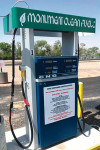BioCycle June 2014

This Grand Junction (Colorado) fueling station delivers biogas-based CNG generated at the Persigo Wastewater Treatment Facility. Image courtesy of Colorado Energy Office
Grand Junction, Colorado: Wastewater Plant Biogas To Vehicle Fuel
In May, the Grand Junction City Council voted unanimously to give city staff the go-ahead to create a contract for converting and transporting biogas from its Persigo Wastewater Treatment Facility to the city’s CNG fueling station. An estimated 100,000 cubic feet of methane gas is generated daily at Persigo. Officials at the City of Grand Junction first began exploring alternatives to diesel fuel in 2007, when they commissioned a study on the potential to recover biogas (or renewable natural gas) from its wastewater treatment operations, refine the gas, and use it in vehicles or inject pipeline-quality gas into the natural gas distribution system. The study findings indicated that the potential biogas resource could support the entire fuel demand of the city’s refuse hauling fleet. However, the cost to recover and upgrade the biogas at that time did not warrant moving forward with a project, according to a case study in a 2012 report by the Colorado Energy Office, “Experiences With Compressed Natural Gas in Colorado Vehicle Fleets.” “In 2009, the City of Grand Junction faced vehicle fuel budget shortfalls,” explains the report. “City officials began seeking ways to reduce fleet costs, environmental impacts, and reliance on imported fuels. CNG represented a technically and economically viable substitute for diesel fuel. Refuse trucks once again were the focus of investigation, this time using natural gas, due to the availability of OEM equipment suitable for that application.”
Grand Junction installed a CNG fueling station and began using CNG vehicles in 2011. By the end of 2012, 8 of its 12 refuse trucks, as well as a street sweeper and a dump truck, were CNG-fueled. The city partnered with Monument Clean Fuels to install a fast-fill station that is accessible to the public (part of a grant funding requirement). The CNG fueling station connects with Xcel Energy’s natural gas distribution line. A “time-fill” station is used for the city fleet, as well as two CNG buses operated by a local transit authority.
Rosemont, Illinois: Dairy Sustainability Awards
Two farm digesters were recipients of the Innovation Center for U.S. Dairy’s third annual Sustainability Awards, presented in May. The program recognizes dairy farms, businesses and collaborative partnerships that are committed to stewardship and sustainability. “The award winners embody the dairy industry’s pledge to provide a healthy future for the next generation through nutritious foods and beverages, community development and innovative business practices,” said Barbara O’Brien, president of the Innovation Center for U.S. Dairy at the award ceremony. The winners were selected based on results as measured by economic, environmental and community impact, also known as triple-bottom-line success. An independent panel of judges also assessed the potential for adoption by others, demonstrated learning, innovation, improvement and scalability.
The Sensenig Dairy in Kirkwood, Pennsylvania installed a complete mix RCM digester that began operating in 2013. Owners Cliff and Andrea Sensenig had purchased the dairy from Cliff’s father in 2009 and shortly thereafter, milk prices crashed. “We needed to supplement our income, and looked at hog barns and chicken farms, but that was too big of an investment at the time,” recalls Andrea Sensenig. “Then we learned about anaerobic digestion. We only have 100 dairy cows, which wasn’t enough to produce an adequate amount of energy. Cliff’s uncle has a dairy farm on one side of our farm, and he has 150 cows. An uncle on the other side of our farm has 2,000 hogs and 30,000 chickens. All together, that was enough manure to go ahead with a digester.” The Sensenigs installed a 200 kW engine, generating about 1.4 million kWh/year. The dairy has a power purchase agreement with Pennsylvania Power & Light.
Vander Haak Dairy in Lynden, Washington, a 500-cow dairy, was the other digester to receive a Sustainability Award. Started up in 2004, it was Washington State’s first dairy digester, built as a collaboration between Vander Haak Dairy, Washington State University and Andgar Corporation (licensee for DVO, Inc.’s complete mix digester system) to track technology development and monitoring. In 2012, Steve Vander Haak assumed ownership of his family’s 65-year-old dairy. In addition to creating renewable energy and additional revenue streams for his farm, Vander Haak started taking organics from area food processors. As part of the research collaboration with WSU and Andgar, the Vander Haak digester was the first demonstration site for full application of emerging technology to recover nitrogen, ammonia and phosphorus from digested manure. Today, notes the Innovation Center’s write-up of the digester facility, 70 percent of manure solids are removed and recycled, and Vander Haak recovers 600,000 pounds of ammonium sulfate fertilizer and 3 million pounds of phosphorus-rich solids, both of which are used in crop production. The dairy has a 600 kW Guascor engine packaged by Martin Machinery and sells power to Puget Sound Energy.













